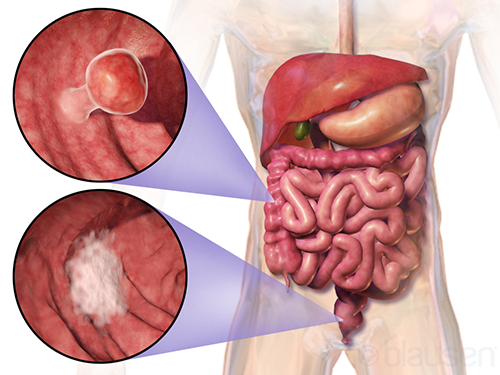
A new study led by researchers at The University of Texas MD Anderson Cancer Center has uncovered genetic mutations that could potentially fuel early cancer growth in precancerous colorectal tissue from high-risk patients. This is the first study to use whole-exome sequencing (WES) to characterize genetic changes in precancerous polyps and in nearby tissue that has not yet transformed into polyps. In addition to mutations at very early stages of cancer development, the findings identify potential drug targets for colorectal cancer (CRC) prevention.
“Our study provides researchers with a catalog of genomic changes that precede the development of colorectal cancer in patients with FAP [familial adenomatous polyposis], a genetic condition in which patients have a 100% chance of developing colorectal cancer at some point very early in their life,” explained co-senior study author Eduardo Vilar-Sanchez, M.D., Ph.D., assistant professor, in the Department of Clinical Cancer Prevention at MD Anderson. “This identifies numerous molecules to investigate as potential targets for colorectal cancer prevention therapeutics. Such chemopreventive agents could benefit not just patients with FAP, but also adults who have had polyps removed and those at high risk for colorectal cancer who decline screening.”
While most of the genetic changes present in advanced CRC are known, those occurring before cancer develops have remained elusive. To identify the earliest mutations, the research team studied polyps and nearby colorectal tissue, or mucosa, from patients with FAP, a hereditary cancer syndrome caused by an inherited mutation in the APC gene.
APC mutations are responsible for 80% of CRC cases, making FAP a particularly attractive model for studying CRC development. Although responsible for only 1% of all diagnoses, patients with FAP have a 100% lifetime risk of developing CRC without preventive actions.
“We have a great need to identify prevention strategies in these populations,” remarked Dr. Vilar-Sanchez. “The idea is to develop a mini premalignant genome atlas to better understand the genomic events in small polyps very early on. Our study sets the groundwork to identify novel biomarkers or targets for chemoprevention.”
The investigators characterized genetic changes in polyps and adjacent mucosa, which, despite appearing normal, is considered “at-risk” tissue. WES was performed on 25 colorectal polyps, 10 adjacent mucosa, and 12 blood samples from 12 patients with FAP.
The findings from this study were published recently in Cancer Prevention Research in an article entitled “Genomic Landscape of Colorectal Mucosa and Adenomas.”
“In addition to looking for genetic mutations in a small fraction of the DNA, there is a very limited amount of total DNA to study, since the polyps are small,” stated co-senior author Paul Scheet, Ph.D., associate professor in the Department of Epidemiology, at MD Anderson “As these lesions are at a very early stage of potential transition to malignancy, assessing mutations demands a highly sensitive method that makes use of all available knowledge.”
The research team identified 2314 genetic changes in polyps, with an average of 83 mutations per polyp and an average rate of 1.75 mutations per megabase, or 1 million DNA bases. In adjacent mucosa, the researchers discovered 279 alterations, with an average of 27 mutations per sample and an average rate of 0.49 mutations per megabase.
Many of the mutations seemed to cluster together around genes that work in tandem for cell-signaling networks. Members of one network called the Wnt signaling pathway, which includes the APC gene, appears to be especially important for the transformation of mucosa to polyps.
“Wnt is the dominant driver for these types of polyps at a very early stage. It is completely central to the development of premalignancy in colorectal cancer, and targeting Wnt should be a priority for chemoprevention,” noted Dr. Vilar-Sanchez.
After studying the mutations identified in these samples, the research team found at least 23% of mutations in the polyps already were present in the at-risk mucosa. A further comparison between polyps and Stage I cancers from The Cancer Genome Atlas (TCGA) revealed greater similarity between premalignant and cancerous tissue than expected.
“Mutation rates of adenomas were surprisingly very close to the mutation rates you will find with Stage I colorectal cancers,” Dr. Vilar-Sanchez stated, “You obviously see the rates go up, but between polyps and cancers, there is a good degree of overlap.”
Dr. Vilar-Sanchez continued, stating that “our information provides a much better understanding of the sequence of genetic events in colorectal cancer premalignancy. This is an important step because there is interest in the cancer prevention community in developing a 'Pre-Cancer Genome Atlas' that mirrors the information on invasive cancers that is in the TCGA.”













